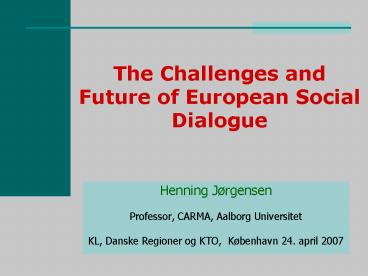The Challenges and Future of European Social Dialogue - PowerPoint PPT Presentation
1 / 22
Title:
The Challenges and Future of European Social Dialogue
Description:
The Challenges and Future of European Social Dialogue. Henning J rgensen ... and employment (Social Partners Commission Troika of Heads of State and Government) ... – PowerPoint PPT presentation
Number of Views:73
Avg rating:3.0/5.0
Title: The Challenges and Future of European Social Dialogue
1
The Challenges and Future of European Social
Dialogue
- Henning Jørgensen
- Professor, CARMA, Aalborg Universitet
- KL, Danske Regioner og KTO, København 24. april
2007
2
What place for Social Dialogue at EU level?
- Strong formal recognition
- Art. 138 of the Treaty
- Art. 139 of the Treaty
- (Constitution, article 1-48)
3
Social dialogue element of governance
Directives Europen Work Councils Working
information and consultation Sexual
harassment Insolvency Asbestos Data
protection Working time
Negotiated agreements Parental leave Part-time
work Fixed-term contracts Telework Stress at work
In progress Harassment and violence at work EWC
revision
4
Why a social dialogue?
Better governance (consultation)
Better implementation (nationally)
Bargaining (jointinitiatives)
5
Tripartite dialogue
Tripartite social summit for growth and
employment (Social Partners Commission Troika
of Heads of State and Government)
Dialogue on vocational training
Dialogue on social protection
Macro-economic dialogue
Dialogue on employment
Meeting(educational ministers)
Meeting (social partners)
Meeting(on EES)
Meeting(social affair ministers)
6
Tripartite social summit for growth and employment
Val Duchessesocial dialogue
Bipartite dialogue
Sectoral level dialogue committees(34)
Company levelEWC
7
What outcomes can be expected?
Agreementsestablishing standards
Framework agreements
Autonomous agreements
Framework for action
Recommendations concerning standards and
principles
Guidelines and codes of conduct
Policy orientations
Joint opinions
Exchange of information
Declarations
Tools
Rules of procedure
Procedural texts
Confusion!
8
The autonomy of the social dialogue
Low commitment
Stronger commitment?
Framework agreements
Communityinitiative
Compendium
Autonomy
Frameworkfor actions
Declarationsor joint opinions
Autonomousagreements
Socialpartnersinitiative
Recommen-dations
Taking responsibility?
9
Problems for Social Dialogue Policy Making
- Employers do not want to play except put under
pressure - Employers have a cheap exit strategy
non-organization - It is easier for ETUC to act as political lobby
than to organize industrial action or bargaining - The second autonomous work programme of the
Social Partners (2006-2008) is modest in
ambitions
10
Problems for Social Dialogue Implementation
- The Commission is like Bismarck but without
power of delivery - No European institutional set-up for mediation
and conciliation - The Green book of the Commission from November
2006 mostly talks about flexibility and
segmentation within the labour market
11
Sectoral Social Dialogue
- New common committees were established during the
1980es and the 1990es - In 1998 the EU harmonized the system Social
Dialogue Committees intended to promote
dialogue between the social partners at European
level - Must be seen as part of a genuine European
collective bargaining system to be constructed - 1998 20 committees
- 2007 34 committees
12
Information, consultation og participation
- Direct and indirect participation of wage earners
is promoted by the EU - Directives have been made, amongst these EWCs
(1994/95) - Information and consultation (1977 2002)
- Directive on influence in European compagnies
(2001)
13
EWC coverageOf 2169 covered companies 737 have
EWCs and they employ 13.1 million workers (64 of
20.83 million in Europe)
around one third of the covered companies have an
EWC
13.1 million workers represented in EWCs
Data source Kerckhofs/Pas (eds) (2004)
14
Parties covered by Collective Agreements
Source ETUI, European Works Councils database,
June 2005 and Eiro
15
Levels of Collective Bargaining
Source ETUI, European Works Councils database,
June 2005 and EIRO
16
Collective Bargaining Coverage
Source ETUI, European Works Councils database,
June 2005 and EIRO
17
Trade Union membership 1993-2003 (in 1,000)
Source EIRO
18
Influence of Tripartite Concertation on
Collective Bargaining
Source ETUI, European Works Councils database,
June 2005 and EIRO
19
Consultation process under Art. 138 (2)
2006/2007
- ISSUES
- Green Paper 06
- Reconciliation of professional and private life
- Inclusion of people furthest from the labour
market - Violence at work
- Transnational collective bargaining
- Flexicurity
- REACTIONS
- 1st consultation,
- 1st consultation 06, separate opinions
- 1st consultation 06, separate opinions
- Joint seminar 05, negotiations concluded 06
- 2 study seminars 06, 1st consultation upcoming 07
- Upcoming June 2007
20
The European Council believe in Flexicurity!
- In this context, the European Council asks
Member States to direct special attention to the
key challenge of "flexicurity" (balancing
flexibility and security) Europe has to exploit
the positive interdependencies between
competitiveness, employment and social security.
The Commission, jointly with Member States and
social partners, will explore the development of
a set of common principles on flexicurity.
Presidency conclusions, European Council,
Brussels, 23-24 March 2006
21
A new Chart of Europe also of the position of
the Social Partners?
Source Employment in Europe 2006
22
Works better with a safety net and Social
Partners in pivotal positions































